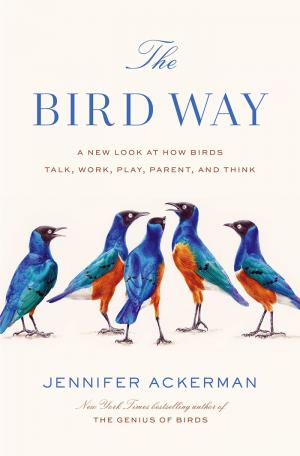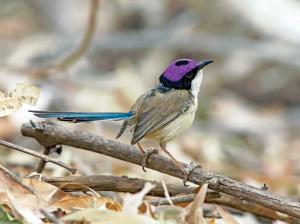By Nancy Brannon, Ph.D.
So many bird events recently converged early this year that this seemed the appropriate time to tell you about Jennifer Ackerman’s book, The Bird Way. January 5, 2022 was National Bird Day. The North Delta Winter Birding field trip in the Mississippi Delta was January 15, 2022. The 25th Annual Great Backyard Bird Count runs February 18–21, 2022. In December 2021, “an album made entirely of endangered bird sounds perched at No. 3 on the country's top 50 albums chart – ahead of Taylor Swift,” NPR reported. “Songs Of Disappearance is an entire album of calls from endangered Australian birds.” Anthony Albrecht, a musician and Ph.D. candidate at Charles Darwin University, produced the album with his arts organization, the Bowerbird Collective. And we publish the Field Trial Review this February, with its focus on Bobwhite Quail, the center of attention at the National Championship for Field Trialing Bird Dogs at Ames Plantation in Grand Junction, Tenn.
If anyone ever calls you a “bird brain,” consider it the highest compliment anyone could offer you. A bird’s brain may be approximately the size of a walnut, but “birds pack more brain cells into a smaller space; they have higher neuron counts in their small brains than do mammals or primates of similar brain size,” scientists have found. Ackerman’s research for her book reveals that birds are one of the most (if not the most) intelligent, innovative, curious, whimsical, multilingual, playful, and creative species on the planet. She covers five main categories of birds’ way of life: talk and communication; work and play; love and wooing; and parenting skills.
Talk
How many languages do you speak? Birds speak multiple languages and dialects; they can understand each other and are, thus, multilingual. They can even understand communication among other species, especially when it comes to alarm calls for predators or danger. “Birds can pack so much information into their calls – type of predator, perched or in flight, near or far, how fast approaching, how dangerous,” etc. Birds are accomplished vocal imitators, too. We are all familiar with the multiple songs of the northern Mockingbird and the Blue Jay’s ability to imitate a Hawk. This requires vocal learning and the use of mirror neurons, all linked to higher cognitive functioning.
Work
Finding food is essential and birds will go to great lengths to get a good meal. And finding a good meal requires multiple sensory capabilities, like keen smell and eyesight. In this chapter, Ackerman clears up several myths about turkey vultures, who “have gotten a bad rap. Those naked heads relieved of adornment are extremely hygienic. They actually prefer fresher carrion. And they provide a vital, vastly underrated, service to the environment: the quick, competent cleanup and recycling of dead creatures.”
Regarding eyesight, “birds see a massive spectrum of color our brains are simply incapable of processing.” And “birds have a fourth color cone that is sensitive to ultraviolet wavelengths,” which allows them to perceive another whole dimension of color.”
Did you know that “most owls listen for their food?”
Birds have the capability of compound tool construction, combining three or four elements to make one long tool.
Biologist Sean O’Donnell at Drexel University who has studied birds extensively finds that birds are capable of mental time travel – the ability to travel in the mind to remember the specifics of past events and to use this memory to plan for future actions. This allows hummingbirds, for example, to remember what flowers they’ve visited and when and for caching birds like jays and nutcrackers to remember where they hid things like food for future use.
Play
When my husband Tommy is out cutting a hay field, he is fascinated to watch the flying acrobatics of Mississippi Kites. University of California Davis wildlife ecologist Dirk Van Vuren has also witnessed common ravens on Santa Cruz Island performing elaborate acrobatic rolls like jet pilots and executing Immelmann turns, something Tommy has observed the kites doing, too.
Gordon Burghardt, evolutionary psychologist at the University of Tennessee, Knoxville came up with a set of five criteria for recognizing play in any species. He and others have found play in unexpected places in the animal world. Did you know that all variety of birds throw things? A number of birds enjoy a good ride, like Adelie penguins surfing on small ice floes along a tide run. “And parrots? Why eat that flower sitting upright when you can roll yourself over a branch, hand upside down, and nibble on it from below?”
Ravens are known for their ability to invent all variety of games. Mathias Osvath, a cognitive zoologist at Lund University, observed a raven, housed in an aviary near an electric fence that enclosed horses on a farm, who learned to imitate the click of the electric fence just to get a rise from the horses!
Osvah says, “Animals quickly understand when another animal is playing, even if it’s a different species.” And play contagion isn’t a simple matter of behavioral synchronization; it’s the play mood that is contagious. And “this kind of emotional contagion is considered a building block of empathy.”
“Clowns of the Mountains” describes the play habits of kea, large parrots with a gorgeous olive green on their backs and underwings of fiery reddish orange. They are called “clowns of the mountains” in their native region of the Southern Alps of New Zealand and, along with ravens, are considered the most playful birds on the planet. “Kea seem to understand the old clown saying, ‘Laugh and the world laughs with you…’”
Love
Wooing behavior in birds is manifested in a variety of ways, with song, dance, and elaborate, ostentatious courtship displays. For example, “the palm cockatoo courts his mate with a rat-a-tat rhythm of love. This bird is so skilled at drumming that it’s known as the Ringo Starr of the bird world.”
Humans aren’t the only ones who value shiny, glitzy objects in courtship. Bowerbirds go to great pains to impress females by building elaborate bowers decorated with colorful objects. Furthermore, he stands at the edge of the long avenue entrance to his bower and parades his decorations in front of the female. Other male birds enhance their displays with a trill song and sweet courtly flower presentations.
Parenting
This chapter covers the wide range of parenting strategies of birds from styles of nest building, sizes and shapes of eggs, to young rearing styles. The spectrum of bird parenting strategies ranges from fierce protection to complete neglect. Some birds minimize parental care, using geothermal heat to incubate their eggs or handing over care to other species. Others rely on biparental care, female-only care, male-only care, and cooperative breeding and communal care.
The Last Word
Summarizing her extensive research into the bird realm, Ackerman reminds the reader that “our old mistaken biases and assumptions about birds are giving way to more nuanced understanding of birds and their behavior.
“To witness bird behavior in its full range is to glean some perspective on our own behavior.
“When I think about what we are doing to our fellow travelers on this planet, the planet itself, I feel a wave of despair. Over the past decades, ornithologists have found that birds that depend on insects for sustenance are rapidly declining. The culprit is not just habitat destruction, but starvation from the disappearance of their primary diet – beetles, dragonflies, and other insects.
“A 2019 study found that over the past twenty-five years, populations of birds that depend on insects fell by 13% across Europe and by almost 30% over Denmark. One in four birds in the US and Canada have disappeared since 1970 – nearly three billion birds. The vanished species span the spectrum from meadowlarks, warblers, and swallows to robins and sparrows. They’re gone from all habitats, primarily due to habitat loss from development and agriculture, as well as pesticide use. Insecticides known as neonicotinoids prevent migratory birds from gaining the body mass and fat stores they need to start their journeys in a timely fashion. One can’t help but think of Rachel Carson’s prescient words in Silent Spring: ‘On the morning that had once throbbed with the dawn chorus of scores of bird voices, there was now no sound.’”
There are a few glimmers of hope in the resurgence of some bird species, but our world will greatly diminished if we do not act immediately to curtail the destructive ways of human behavior.
“The word auspicious, meaning favorable or promising success, comes from the Latin auspex, or observer of birds. We would do well to watch birds more and learn while we can from their marvelous ways of being.”
Source:
https://www.npr.org/2022/01/09/1070605843/endangered-bird-songs-chart-top-50-album
Photo cutline:
The purple-crowned fairy-wren is another one of the birds featured on the hit album Songs of Disappearance. (photo: Silva Vaughan Jones/Birdlife Australia)
So many bird events recently converged early this year that this seemed the appropriate time to tell you about Jennifer Ackerman’s book, The Bird Way. January 5, 2022 was National Bird Day. The North Delta Winter Birding field trip in the Mississippi Delta was January 15, 2022. The 25th Annual Great Backyard Bird Count runs February 18–21, 2022. In December 2021, “an album made entirely of endangered bird sounds perched at No. 3 on the country's top 50 albums chart – ahead of Taylor Swift,” NPR reported. “Songs Of Disappearance is an entire album of calls from endangered Australian birds.” Anthony Albrecht, a musician and Ph.D. candidate at Charles Darwin University, produced the album with his arts organization, the Bowerbird Collective. And we publish the Field Trial Review this February, with its focus on Bobwhite Quail, the center of attention at the National Championship for Field Trialing Bird Dogs at Ames Plantation in Grand Junction, Tenn.
If anyone ever calls you a “bird brain,” consider it the highest compliment anyone could offer you. A bird’s brain may be approximately the size of a walnut, but “birds pack more brain cells into a smaller space; they have higher neuron counts in their small brains than do mammals or primates of similar brain size,” scientists have found. Ackerman’s research for her book reveals that birds are one of the most (if not the most) intelligent, innovative, curious, whimsical, multilingual, playful, and creative species on the planet. She covers five main categories of birds’ way of life: talk and communication; work and play; love and wooing; and parenting skills.
Talk
How many languages do you speak? Birds speak multiple languages and dialects; they can understand each other and are, thus, multilingual. They can even understand communication among other species, especially when it comes to alarm calls for predators or danger. “Birds can pack so much information into their calls – type of predator, perched or in flight, near or far, how fast approaching, how dangerous,” etc. Birds are accomplished vocal imitators, too. We are all familiar with the multiple songs of the northern Mockingbird and the Blue Jay’s ability to imitate a Hawk. This requires vocal learning and the use of mirror neurons, all linked to higher cognitive functioning.
Work
Finding food is essential and birds will go to great lengths to get a good meal. And finding a good meal requires multiple sensory capabilities, like keen smell and eyesight. In this chapter, Ackerman clears up several myths about turkey vultures, who “have gotten a bad rap. Those naked heads relieved of adornment are extremely hygienic. They actually prefer fresher carrion. And they provide a vital, vastly underrated, service to the environment: the quick, competent cleanup and recycling of dead creatures.”
Regarding eyesight, “birds see a massive spectrum of color our brains are simply incapable of processing.” And “birds have a fourth color cone that is sensitive to ultraviolet wavelengths,” which allows them to perceive another whole dimension of color.”
Did you know that “most owls listen for their food?”
Birds have the capability of compound tool construction, combining three or four elements to make one long tool.
Biologist Sean O’Donnell at Drexel University who has studied birds extensively finds that birds are capable of mental time travel – the ability to travel in the mind to remember the specifics of past events and to use this memory to plan for future actions. This allows hummingbirds, for example, to remember what flowers they’ve visited and when and for caching birds like jays and nutcrackers to remember where they hid things like food for future use.
Play
When my husband Tommy is out cutting a hay field, he is fascinated to watch the flying acrobatics of Mississippi Kites. University of California Davis wildlife ecologist Dirk Van Vuren has also witnessed common ravens on Santa Cruz Island performing elaborate acrobatic rolls like jet pilots and executing Immelmann turns, something Tommy has observed the kites doing, too.
Gordon Burghardt, evolutionary psychologist at the University of Tennessee, Knoxville came up with a set of five criteria for recognizing play in any species. He and others have found play in unexpected places in the animal world. Did you know that all variety of birds throw things? A number of birds enjoy a good ride, like Adelie penguins surfing on small ice floes along a tide run. “And parrots? Why eat that flower sitting upright when you can roll yourself over a branch, hand upside down, and nibble on it from below?”
Ravens are known for their ability to invent all variety of games. Mathias Osvath, a cognitive zoologist at Lund University, observed a raven, housed in an aviary near an electric fence that enclosed horses on a farm, who learned to imitate the click of the electric fence just to get a rise from the horses!
Osvah says, “Animals quickly understand when another animal is playing, even if it’s a different species.” And play contagion isn’t a simple matter of behavioral synchronization; it’s the play mood that is contagious. And “this kind of emotional contagion is considered a building block of empathy.”
“Clowns of the Mountains” describes the play habits of kea, large parrots with a gorgeous olive green on their backs and underwings of fiery reddish orange. They are called “clowns of the mountains” in their native region of the Southern Alps of New Zealand and, along with ravens, are considered the most playful birds on the planet. “Kea seem to understand the old clown saying, ‘Laugh and the world laughs with you…’”
Love
Wooing behavior in birds is manifested in a variety of ways, with song, dance, and elaborate, ostentatious courtship displays. For example, “the palm cockatoo courts his mate with a rat-a-tat rhythm of love. This bird is so skilled at drumming that it’s known as the Ringo Starr of the bird world.”
Humans aren’t the only ones who value shiny, glitzy objects in courtship. Bowerbirds go to great pains to impress females by building elaborate bowers decorated with colorful objects. Furthermore, he stands at the edge of the long avenue entrance to his bower and parades his decorations in front of the female. Other male birds enhance their displays with a trill song and sweet courtly flower presentations.
Parenting
This chapter covers the wide range of parenting strategies of birds from styles of nest building, sizes and shapes of eggs, to young rearing styles. The spectrum of bird parenting strategies ranges from fierce protection to complete neglect. Some birds minimize parental care, using geothermal heat to incubate their eggs or handing over care to other species. Others rely on biparental care, female-only care, male-only care, and cooperative breeding and communal care.
The Last Word
Summarizing her extensive research into the bird realm, Ackerman reminds the reader that “our old mistaken biases and assumptions about birds are giving way to more nuanced understanding of birds and their behavior.
“To witness bird behavior in its full range is to glean some perspective on our own behavior.
“When I think about what we are doing to our fellow travelers on this planet, the planet itself, I feel a wave of despair. Over the past decades, ornithologists have found that birds that depend on insects for sustenance are rapidly declining. The culprit is not just habitat destruction, but starvation from the disappearance of their primary diet – beetles, dragonflies, and other insects.
“A 2019 study found that over the past twenty-five years, populations of birds that depend on insects fell by 13% across Europe and by almost 30% over Denmark. One in four birds in the US and Canada have disappeared since 1970 – nearly three billion birds. The vanished species span the spectrum from meadowlarks, warblers, and swallows to robins and sparrows. They’re gone from all habitats, primarily due to habitat loss from development and agriculture, as well as pesticide use. Insecticides known as neonicotinoids prevent migratory birds from gaining the body mass and fat stores they need to start their journeys in a timely fashion. One can’t help but think of Rachel Carson’s prescient words in Silent Spring: ‘On the morning that had once throbbed with the dawn chorus of scores of bird voices, there was now no sound.’”
There are a few glimmers of hope in the resurgence of some bird species, but our world will greatly diminished if we do not act immediately to curtail the destructive ways of human behavior.
“The word auspicious, meaning favorable or promising success, comes from the Latin auspex, or observer of birds. We would do well to watch birds more and learn while we can from their marvelous ways of being.”
Source:
https://www.npr.org/2022/01/09/1070605843/endangered-bird-songs-chart-top-50-album
Photo cutline:
The purple-crowned fairy-wren is another one of the birds featured on the hit album Songs of Disappearance. (photo: Silva Vaughan Jones/Birdlife Australia)










